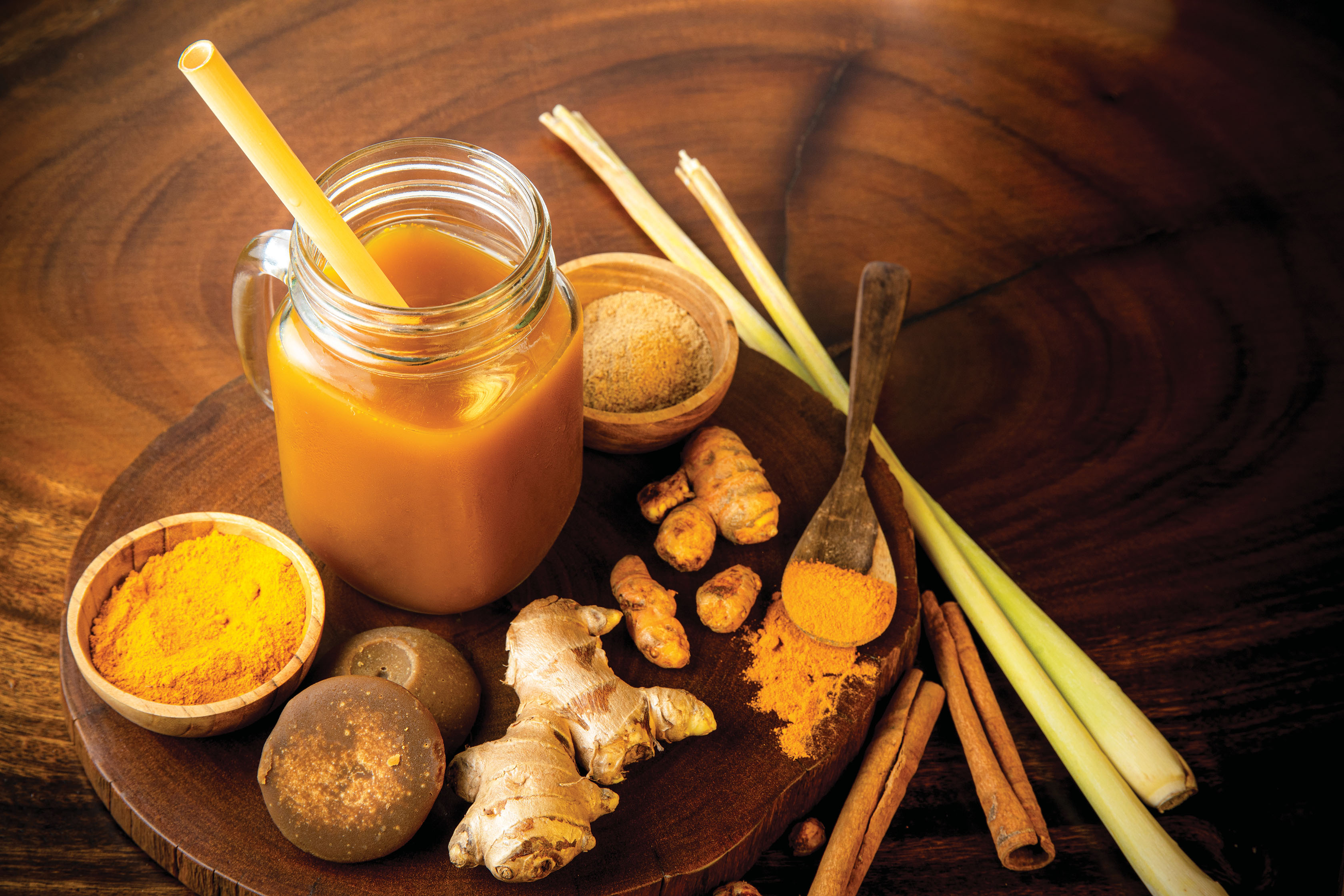
Jamu as the “next expresso?” but with immune boosting, anti inflammatory properties with orange and turmeric!
Indonesians are already familiar with the health benefits of these traditional herbal preparations but how will they fare in a post-COVID world?
THE world is still reeling from the deadly effects of the COVID-19 pandemic. While the race to find a safe and effective vaccine is now over and countries are fighting back with their vaccination programmes, there is a movement to also find more natural and holistic ways to maintain one’s health using herbal medicine which have antimicrobial or antiviral, anti-inflammatory, and immunostimulatory properties.
For centuries now the indigenous science for medicinal plants has been thriving amongst the Chinese and Indian people; there are cultures worldwide, in fact, to which this is an integral part since time immemorial. One must remember the identification of medicinal plants growing on community land for the procurement of traditional medicinal materials has been carried out by the community since the ancient days.
Ever since the outbreak of COVID-19 pandemic people in Indonesia have been stocking up on jamu, derived from the ancient Javanese word “jampi” (magic potion), a traditional herbal drink known for its immunity-boosting properties and the maintanence of good health.

President Jokowi prefers to drink his own homemade jamu to prevent illness and maintain his health and stamina. He shared his jamu recipe in a vlog as a mixture of temulawak (curcuma zanthorrhiza, ginger and turmeric). Photo: still from President Jokowi Instagram video)
For over 1,200 years now, since the Mataram Kingdom in Java, the Javanese have used medicinal plants as a deterrent / inhibitor to diseases found in the body, by drinking herbs sourced from medicinal plants. A homemade product, jamu, is made with fresh and raw ingredients like tamarind, galangal, ginger, and turmeric. From grannies in the urban spaces to healers in the village communities, jamu has been the go-to herbal drink to stave off ill health. Even President Jokowi swears by his jamu which he has been taking for almost 20 years!
Indonesia is well regarded for the growth of various plants of empon-empon or herbs and spices that go into the making of traditional Javanese medicinal drinks, popular for maintaining health and treating diseases, as they are considered to be safe from chemical drugs.
Jamu is very much part of life in Indonesian homes and in fact it’s not unusual to find peddlers, known as jamugendong, going around selling their wares from place to place; this is, of course, common enough practice amongst many world communities. As is also the fact that knowledge of traditional herbal formulas have been preserved and transmitted down orally from one generation to another. Turmeric and tamarind for example are mainstay components for jamukunirasem, while in jamuberaskencur, the supporting components are rice and kaempferiagalanga in addition to kawak acid, kedawung seeds, ginger rhizome, cardamom seeds, temukunci, cinnamon, turmeric, lemon and nutmeg. To scale down the bitter edge natural sweeteners such as brown sugar, granulated sugar, rock sugar or honey were added to the concoction.
There is no one given formula for jamu; in fact, across Indonesia hundreds of ethnic groups have, over the centuries, evolved their own specific traditional prescriptions, sourced from the medicinal plants from the botanical wealth on community land. These are often created from a single ingredient or a combination of several constituents. The mainstay of jamu, however, for long has been plants from the ginger family (Zingiberaceae) as also Curcuma, Kaempferia, Zingiber, Alpinia, Elattaria and Costus.
It is also well known that different medicinal plants used in jamu will have different forms of efficacy, even though they are generally good for improving one’s own wellbeing. Little wonder then that the pandemic has also encouraged Indonesian researchers to step up efforts to look into the potential of jamu ingredients as a herbal medicine. In a story published by The Jakarta Post last April, it reported how researchers in Indonesia have started zeroing on the potential for several medicinal plants often used as jamu ingredients, such as turmeric, secang (sappanwood), bitter leaves and galangal, as shared by Mangestuti Agil, a professor at the Pharmacognition and Phytochemistry Department of Airlangga University’s School of Pharmacy in Surabaya, East Java.
The newspaper also reported how market reports have painted a “bright, post-pandemic future for Indonesian jamu.” National jamu sales in 2019 generated Rp 21.5 trillion (US$1.38 billion) in revenue, up 13.1 percent from Rp 19 trillion in 2018, according to figures published by the Indonesian Jamu and Traditional Medicine Producers Group (GP-Jamu).
While last year’s figure remains indeterminable due to the COVID19 outbreak’s impacts on logistics and consumer buying power, the available figures and reports indicate a promising future for the herbal medicine market.

Pre-COVID times: A herbalist in Yogyakarta serving a customer; Jamu is sold through many herbal drink stalls found throughout the country. Photo: Annisa Fitri Muthmainah / Shutterstock.com
The Jakarta Post stated that even amid the economic downturn due to the government’s COVID-19 emergency measures, the first quarter of 2020 saw the jamu and herbal supplements segment contribute more than 68 percent of its Rp 730.72 billion sales revenue, a year-on-year (YOY) increase of 2.4 percent. Meanwhile, Indonesia’s herbal medicine giant Sido Muncul saw its profit jump 10.85 percent YOY to Rp 231.53 billion in January-March. “I think demand has increased because people want to stay healthy during the pandemic, and the profit surge is quite large,” Sido Muncul director Irwan Hidayat, whose family owns majority shares in the company, told The Jakarta Post. Irwan also estimated a 30 percent surge in demand this year, with customers flocking to buy jamu containing plants from the curcuma genus, such as turmeric and ginger. With this promising outlook, he estimated a 10 percent increase in both sales and profit by the end of the year.
This optimistic outlook is borne by other market research reports on how COVID-19 is impacting food and drink markets in Southeast Asia. Mintel, the global market research firm found many consumers are turning to traditional remedies to boost their immune system
According to the Indonesian Institute of Sciences (LIPI) the country has over three-quarters of the more than 40,000 medicinal plants in the world and is an “untapped source of the global market for herbal medicines.”
The newspaper report also included a snapshot of the industry: “In 2018, Indonesia had 1,247 jamu producers, of which 129 were large manufacturers using modern technology. The remaining 1,118 producers were micro, small and medium enterprises (SMEs), the majority of which used traditional jamu production methods. The segment employed up to 15 million workers, comprising 3 million workers in the jamu and traditional medicine segment, and the remaining 12 million workers employed in related sectors and markets that used jamu products, such as the food and beverage and cosmetics industries, as well as the spa services and aromatherapy markets.”
Market observers and industry players are confident that jamu culture can transform and penetrate the pharmaceutical [industry], and through restaurants to become part of the food and beverages industry as well. The hope is that the jamu consumption trend would emerge as the new normal after the crisis. Business research and consultancy Inventure Indonesia even dubbed jamu as “the new espresso” in its report on shifts in consumer behavior as an impact of COVID-19 with predictions that jamu consumption trend would shift from mere functional food to lifestyle.
Some Jamu ingredients and their health benefits:
| Ingredients | Health benefits |
| Turmeric | Turmeric contains curcumin which reduces swelling, pain, headaches, and osteoarthritis. Some people also use it for inflammatory bowel disease, itching, stress, and depression too. |
| Tamarind | An excellent source of dietary fibre which binds toxins, bile salts and surplus cholesterol; reduces blood sugar level and promotes good cardiovascular health due to its potassium content. Rich in organic compounds, it is high in antioxidants. It is also commonly used as a natural laxative, gently aiding digestion and alleviating stomach discomforts due to constipation. It is also effective in aiding weight loss |
| Ginger | Lowers cholesterol levels and also replenishes body’s levels of iron, sodium, vitamins A and C, flavonoids and phytonutrients; also promotes healthy weight and digestion |
| Honey | Also contains high level of oxidants; soothes many minor ailments, reducing cough symptoms and promote better sleep |
| Lime | Rejuvenates skin, boost vitamin C levels and help with iron absorption |







